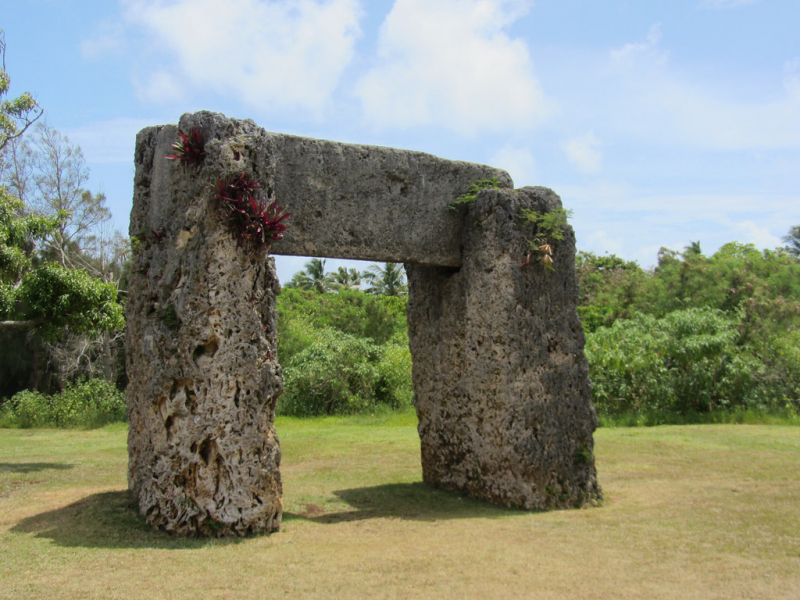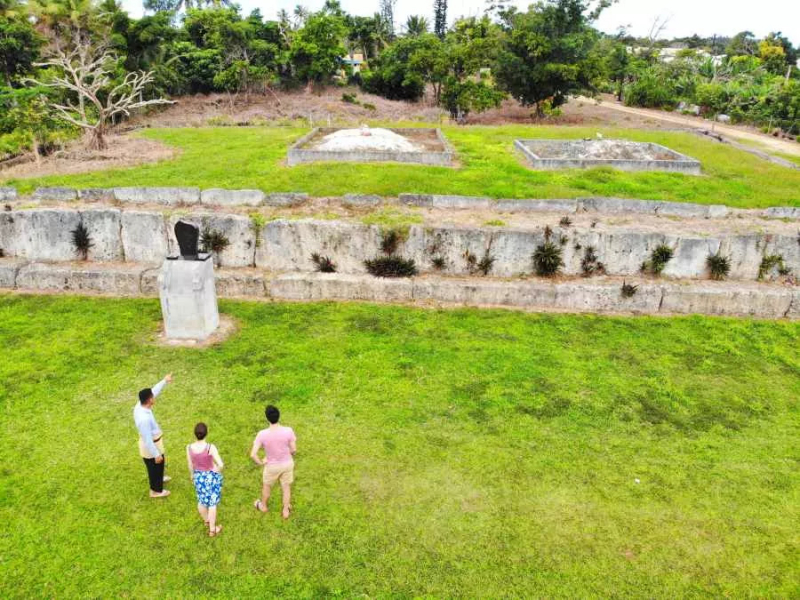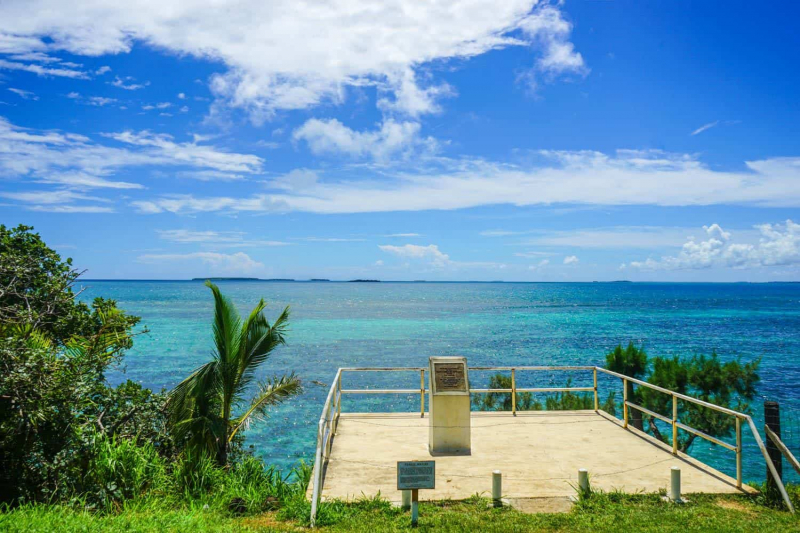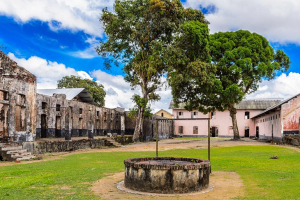Top 6 Most Famous Historical Sites in Tonga
Tonga has a fascinating and colorful history full of kings, colonists, tribes, and cross-cultural contacts. Check out the list below for some of the most ... read more...famous historical sites in Tonga that you may visit.
-
The Ha'amonga 'a Maui is undoubtedly the most famous historical site in Tonga. Tu'i Tonga Tu'itatui, one of Tonga's early monarchs, is supposed to have built this ancient coral stone trilithon in the 13th century. Interpretation panels at the Niutoua site describe the historical hypotheses behind the megalith's construction, while Maka Faakinanga, or the "leaning stone," is a short walk behind the trilithon.
Ha'amonga 'a Maui is a strange TRILITHON on the island of Tongatapu, consisting of two standing stones with a lintel on top. It is around 17 feet tall and 19 feet long. Each slab of coral limestone weighs between 30 and 40 tons. It's been dubbed the "Stonehenge of the Pacific" due to its striking likeness.The term "Maui's Burden" means "Maui's Burden" in Hawaiian, and because the stones are too big for people to lift, it is thought that the god Maui himself transported them from 'Uvea (Wallis Island) and built the monument. They currently live in a small natural preserve on the side of the road.
Archaeologists, on the other hand, appear to agree that the Ha'amonga was built as the entrance to a king's royal palace, Heket, in the early 13th century. It's been speculated that it could have been used for astrological purposes if not for that. However, none of these possibilities have been validated, and the origin of the massive trilithon remains a mystery.
Location: VX72+9Q9, Taufa'ahau Rd, Niutoua, Tonga

Photo: tongapocketguide.com 
Photo: flickr -
Ancient graves are the most common historical site in Tonga, with the Papae 'o Telea royal tombs being among the most prominent. The Papae 'o Telea are examples of just two of roughly 28 royal graves located in the Tongatapu hamlet of Mu'a, each in a pyramid-like stone memorial. Tele'a, a monarch (Tu'i Tonga) who reigned during the 16th century, is buried in one of the graves.
Tonga's ancient masonry structures are unique in the Pacific, and the largest of them, Lapaha's Paepae 'o Tele'a tombs, is being considered for World Heritage Site status. In December 2012, Dr. Geoffrey Clark of the Australian National University's Department of Archaeology and Natural History traveled to Tonga to assist the Lapaha community and the Tonga government in preparing a dossier for formal submission to UNESCO in the hopes of having the Paepae 'o Tele'a Royal Tomb recognized as a World Heritage Site.
The stone graves, which were built on reclaimed land in an old harbor, date back to the Tu'i Tonga chiefdom's Maritime Empire, which began construction of its capital at Lapaha in eastern Tongatapu some 1,000 years ago. "These are some of the best-preserved sites in the Pacific, and the Paepae is the most extensive piece of stonework or the largest masonry monument in terms of the weight of the stone," Dr. Clark added. Much of the structure's foundation is now underground, and the tombs appear aged and drab, unlike when they were first created as gleaming monuments.
Location: Mu’a, Tongatapu

Photo: tongapocketguide.com 
Photo: tongapocketguide.com -
A small monument commemorates Dutchman Abel Tasman's 'discovery' of Tongatapu in 1643 on Tongatapu's northwestern tip. He was returning to Batavia (modern-day Jakarta) after stopping in Tasmania and then New Zealand. He christened Tongatapu 'Amsterdam' with wonderful European sensibility. The Abel Tasman Expedition, the first Europeans to set foot in Tasmania, landed in December 1642, and the monument commemorates their arrival.
On Monday, the Royal Society of Tasmania unveiled a memorial created with the help of locals on the site where Abel Janszoon Tasman raised the Dutch flag in Tasmania in 1642. The Memorial was unveiled by the Administrator, Sir Herbert Nicholls, in front of a group of 27 people in Prince of Wales Bay, on the east coast of the Forestier Peninsula. The monument is made of solid concrete and stands 12 feet 6 inches tall with a 4 foot 6 inch base. It is prominently located on the bay's edge, near to the high water line.
Tongatapu has you covered when it comes to landmarks marking where the first Europeans landed in Tonga, starting with the Abel Tasman Landing Site on the island's northern tip. An information panel at the location describes the first meeting between the Tongan people and the Dutch explorer's crew, and a plaque commemorates the event, which took place on January 21, 1643.
Location: Ha’atafu, Tongatapu

Photo: www.neverendingfootsteps.com 
Photo: Mapio.net -
The Royal Palace, one of the most famous historical sites in Tonga, is located near the Pacific Ocean in the northwest corner of the city, Nukualofa. The King of Tonga's official residence is the wooden Palace, which was erected in 1867. The palace is not open to the public, however it can be seen from the river. The Royal Palace of the Kingdom of Tonga, a small island nation in the Pacific Ocean, is the official house of the nation's royal family, specifically the King of Tonga. The Palace is located on the waterfront in Nuku'alofa, in the northwest of the capital, with views of many distant coral islands.
It is a wooden Palace that was erected in 1867 and can be viewed from the shoreline, albeit it is not open to the public. The nation's capital city has undergone some sort of rebuilding, with the Royal Palace serving as the most prominent structure in the process. Although it has grown to five times its original size, the original Palace remains at the center of the new structure. The Palace will house all of the sovereign powers of a sovereign state like Tonga. Nonetheless, the Palace is not only the heart of the Kingdom, but also the heart of Nuku'alofa's Royal Town. This Royal Town, together with Neiafu in Vava'u, will be ruled by town councils under a Royal Charter issued on November 19, 2010 by King George Tupou V.
The king's old, meter-high stone fence was so sacrosanct that no one dared to sit on it, much less cross it. After 1990, however, King Tufahau Tupou IV erected a 3-meter high grid fence. Around some persons burst through the gates with vehicles after 2000, iron bars were installed to secure the gates. The Royal Palace, an iconic landmark on the waterfront of Nuku'alofa, the nation's capital, stands as a symbol of the Kingdom of Tonga. It is still the royal family's house to this day.
Location: Nuku’alofa, Tongatapu

Photo: tongapocketguide.com 
Photo: trip.com -
The royal burial grounds in central Nukualofa in the Kingdom of Tonga in the southern Pacific Ocean are known as Malaekula or Malae Kula (red square). Tonga's kings and close relatives (spouse, husbands, and children) are buried there. Cousins, nephews, nieces, and inlaws who live a little further away from the mainline are buried elsewhere, primarily in cemeteries. Older kings (such as those of the Tui Tonga dynasty) are primarily buried in Mua's langi.
Malaekula is located along the Hala Tui River, a short distance south of the royal palace (kings road). The actual name of this route is Kings Path, and it refers to the last road that every Tongan King will walk during his reign, leading to his final resting place in Malaekula. Because of the Norfolk pines (a royal tree in Tonga) that were planted by Europeans along this route, it is also known as the Hala Paini (pine road). However, all of the Norfolk pines have vanished due to the deep roots reaching underground waters. When Siaosi Tufahau Tupou I, the first king of modern Tonga, died, the cemetery was created. His tomb is in the middle of the field, visible while looking straight down the Hala Tui from the royal grounds.The Royal Tombs are currently located in central Nuku'alofa, Tonga's capital. Rather than being buried at the dynasty's burial sites after King Siaosi (George) Tupou I died in 1893, the Government decided that because King Tupou I united the country, he and his direct descendants should be buried in central Nuku'alofa. Malaekula was the name of the grounds (Red Ground). The Malaekula is now regarded as a sacred location. Visitors can read about the historical site's significance on several interpretive panels around the perimeter, which are fenced off to the public.
Location: Nuku’alofa, Tongatapu

Photo: pacificdocs.wordpress.com 
Photo: Flickr -
Shirley Baker Monument is the last most famous historical site to see in Tonga. Among the cemetery of 19th and 20th-Century European traders and missionaries, the grave and monumental plaque for the Rev. Shirley Baker can be found. He was Tonga’s first prime minister and advisor to King Tupou I. Also, opposite the site, is a Tongan cemetery decorated with sand and coral mounds.
Shirley Waldemar Baker was a Methodist missionary in Tonga from 1836 to 16 November 1903. He was the founder of Tonga's Free Church and had considerable power under the reign of George Tupou I, who appointed him Prime Minister.
The grave and monument of Tonga's revered first prime minister and adviser to King George Tupou I, the imperious-looking Reverend Doctor Shirley Waldemar Baker (1836–1903), stands amid the graves of various 19th- and early-20th-century German and English traders and missionaries about 800 meters north of Pangai. Directly across the street is a Tongan cemetery with decorative sand and coral mounds.
Location: Pangai, Ha’apai, Tonga

Photo: tongapocketguide.com 
Photo: Masterfile


























